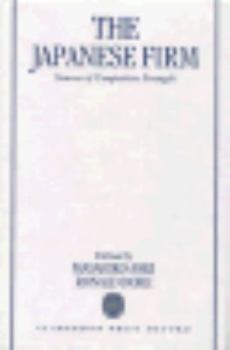The Japanese Firm: Sources of Competitive Strength
Select Format
Select Condition 
Book Overview
Japanese firms have come under close examination by their international counterparts, who seek insight into the sources of Japanese accomplishments. The Japanese Firm reveals the complex network of institutions and practices surrounding the Japanese firm to explain the successes of the Japanese
economy. A team of internationally renowned scholars uses theoretical and empirical work, and combines contributions from the fields of institutional economics,...
Format:Hardcover
Language:English
ISBN:0198288158
ISBN13:9780198288152
Release Date:July 1994
Publisher:Clarendon Press
Length:424 Pages
Weight:1.95 lbs.
Dimensions:1.3" x 6.6" x 9.5"
Customer Reviews
1 rating
A basic material in the Japanese study
Published by Thriftbooks.com User , 21 years ago
This book is one the most cited material in the field of Japanese study. From the late 1980s to the early 1990s, studying the Japanese firms was a fad in social sciences. There was a deluge of papers and books on that subject. It must be the golden age of Japanology. And this book could be regarded as the fruit of such activities. First, editors themselves are the leading figures in the Japanese study, and articles in this book were written by distinguished scholars too. So you can expect the quality papers. Second, almost all the issues raised up to that time are tackled in this volume from organizational learning in the Japanese firm, quality control, lean production, Japanese-style R & D, the human resource management in the Japanese firm, to keiretsu. But just like all other things in the life, this book has its own weaknesses.First, as you can guess from the publication date of this book (1994) and the subtitle of the book (sources of competitive strength), there is no account of why Japanese firms are mired in difficulties now. Poster children of Japanese business like Nissan, Toshiba, Hitachi all have suffered over the 1990s and now. There is no explanation for such troubles. It's natural for most didn't imagine the Japanese economy has stumble more than a decade up to 1995. They thought downturn caused by bubble bursting should be short-term problem. So we can't pillory authors for this weakness. But now it's the obvious problem. Second, as we can guess from the name of editor (Aoki), most articles are confined to incentive or contractual approach in dealing with the firm. Some articles adopt the organizational learning approach. Other approaches on organization than contract theory are few in this book. It goes without saying that this problem doesn't stand for the jaundiced eye of the editors. At the time this book was published, other approaches in organizational studies were not fully competitive. In spite of these two obvious flaws, you'd better read related articles in this book if you are intended to write the paper about the Japanese firm. As I said, articles in this book could be considered as the fruit of pervious studies on the Japanese firm.





